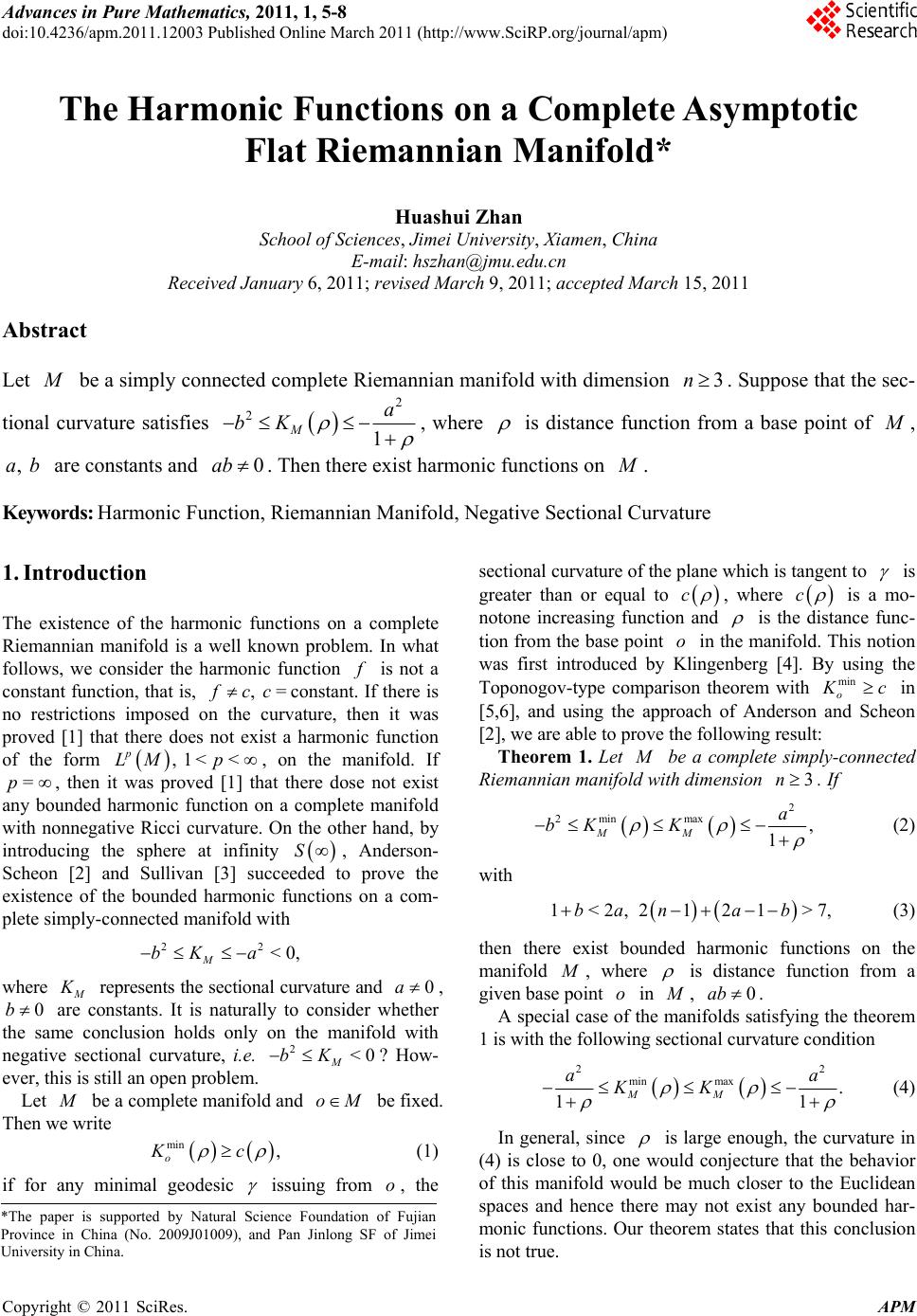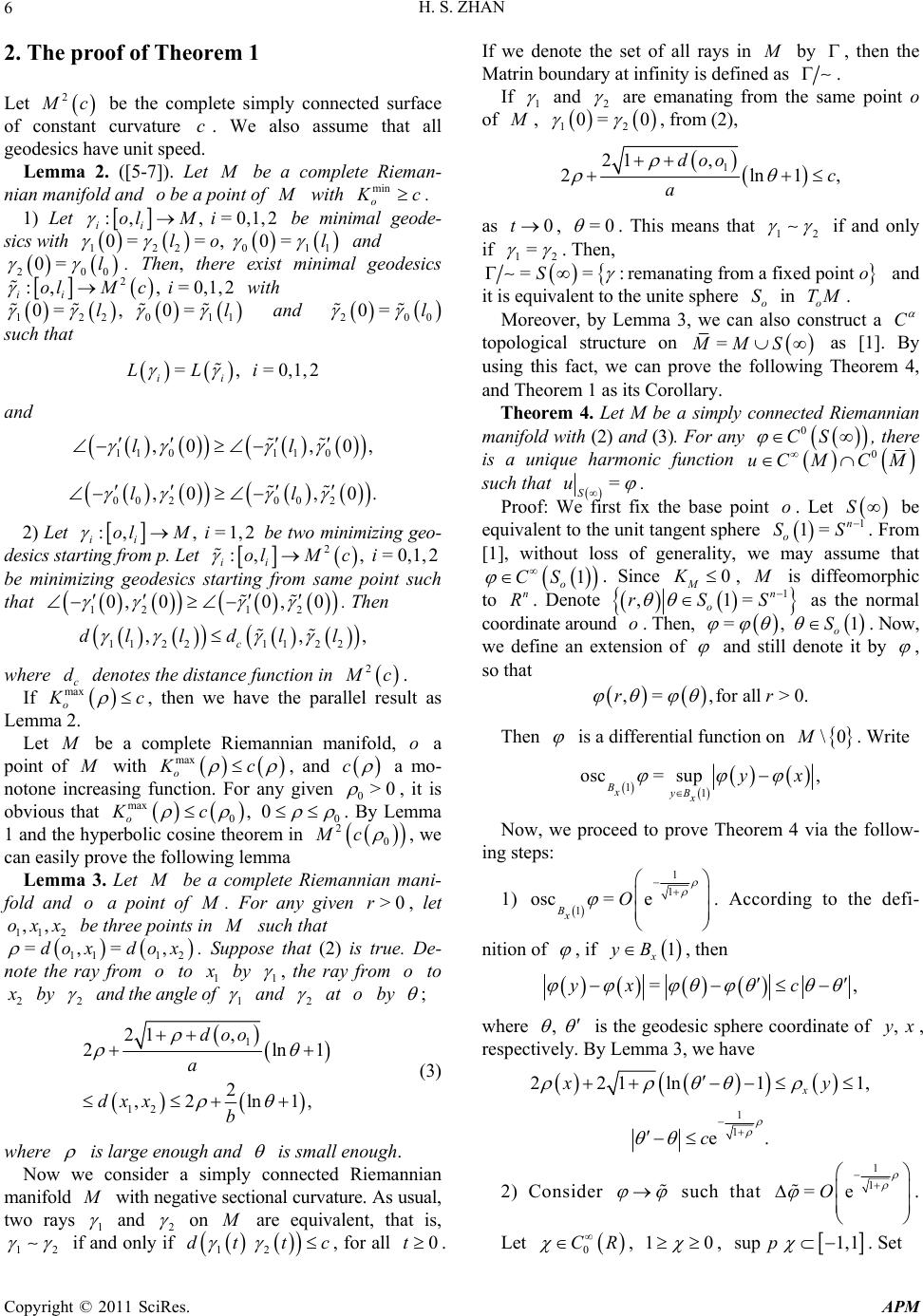 Advances in Pure Mathematics, 2011, 1, 5-8 doi:10.4236/apm.2011.12003 Published Online March 2011 (http://www.SciRP.org/journal/apm) Copyright © 2011 SciRes. APM The Harmonic Functions on a Complete Asymptotic Flat Riemannian Manifold* Huashui Zhan School of Sciences, Jimei University, Xiamen, China E-mail: hszhan@jmu.edu.cn Received January 6, 2011; revised March 9, 2011; accepted March 15, 2011 Abstract Let be a simply connected complete Riemannian manifold with dimension 3n. Suppose that the sec- tional curvature satisfies 2 2 1 Ma bK , where is distance function from a base point of , , ab are constants and 0ab . Then there exist harmonic functions on . Keywords: Harmonic Function, Riemannian Manifold, Negative Sectional Curvature 1. Introduction The existence of the harmonic functions on a complete Riemannian manifold is a well known problem. In what follows, we consider the harmonic function is not a constant function, that is, , = cc constant. If there is no restrictions imposed on the curvature, then it was proved [1] that there does not exist a harmonic function of the form , 1<< p LM p , on the manifold. If =p, then it was proved [1] that there dose not exist any bounded harmonic function on a complete manifold with nonnegative Ricci curvature. On the other hand, by introducing the sphere at infinity S, Anderson- Scheon [2] and Sullivan [3] succeeded to prove the existence of the bounded harmonic functions on a com- plete simply-connected manifold with 22 <0, M bK a where represents the sectional curvature and 0a , 0b are constants. It is naturally to consider whether the same conclusion holds only on the manifold with negative sectional curvature, i.e. 2<0 M bK ? How- ever, this is still an open problem. Let be a complete manifold and oM be fixed. Then we write min , o Kc (1) if for any minimal geodesic issuing from o, the sectional curvature of the plane which is tangent to is greater than or equal to c , where c is a mo- notone increasing function and is the distance func- tion from the base point o in the manifold. This notion was first introduced by Klingenberg [4]. By using the Toponogov-type comparison theorem with min o c in [5,6], and using the approach of Anderson and Scheon [2], we are able to prove the following result: Theorem 1. Let be a complete simply-connected Riemannian manifol d with dimension 3n. If 2 2min max, 1 MM a bK K (2) with 1<2,2 121>7,ba nab (3) then there exist bounded harmonic functions on the manifold , where is distance function from a given base point o in , 0ab . A special case of the manifolds satisfying the theorem 1 is with the following sectional curvature condition 22 min max. 11 MM aa KK (4) In general, since is large enough, the curvature in (4) is close to 0, one would conjecture that the behavior of this manifold would be much closer to the Euclidean spaces and hence there may not exist any bounded har- monic functions. Our theorem states that this conclusion is not true. *The paper is supported by Natural Science Foundation of Fujian Province in China (No. 2009J01009), and Pan Jinlong SF of Jimei University in China.  H. S. ZHAN Copyright © 2011 SciRes. APM 6 2. The proof of Theorem 1 Let 2 c be the complete simply connected surface of constant curvature c. We also assume that all geodesics have unit speed. Lemma 2. ([5-7]). Let be a complete Rieman- nian manifold and obe a point of with min o c. 1) Let :,, =0,1,2 ii olMi be minimal geode- sics with 122 011 0==, 0=lo l and 200 0= l . Then, there exist minimal geodesics 2 :,, =0,1,2 ii olMci with 122011 0=, 0=ll and 200 0= l such that =, =0,1,2 ii LLi and 11 011 0 ,0 ,0,ll 00 200 2 ,0 ,0.ll 2) Let :,, =1,2 ii olMi be two minimizing geo- desics starting from p. Let 2 :,, =0,1,2 ii olMci be minimizing geodesics starting from same point such that 12 12 0, 00, 0 . Then 11 2211 22 ,,, c dl ldl l where c d denotes the distance function in 2 c. If max o c , then we have the parallel result as Lemma 2. Let be a complete Riemannian manifold, o a point of with max o Kc , and c a mo- notone increasing function. For any given 0>0 , it is obvious that max 00 , 0 o Kc . By Lemma 1 and the hyperbolic cosine theorem in 2 0 Mc , we can easily prove the following lemma Lemma 3. Let be a complete Riemannian mani- fold and o a point of . For any given >0r, let 112 ,,oxx be three points in such that 11 12 =,=,dox dox . Suppose that (2) is true. De- note the ray from o to 1 by 1 , the ray from o to 2 by 2 and the angle of 1 and 2 at o by ; 1 12 21 , 2ln1 2 ,2 ln1, doo a dxx b (3) where is large enough and is small enough. Now we consider a simply connected Riemannian manifold with negative sectional curvature. As usual, two rays 1 and 2 on are equivalent, that is, 12 if and only if 12 dt tc , for all 0t. If we denote the set of all rays in by , then the Matrin boundary at infinity is defined as . If 1 and 2 are emanating from the same point o of , 12 0= 0 , from (2), 1 21 , 2ln1, doo c a as 0t, =0 . This means that 12 if and only if 12 = . Then, ==:remanating from a fixed point So and it is equivalent to the unite sphere o S in o TM. Moreover, by Lemma 3, we can also construct a C topological structure on =MMS as [1]. By using this fact, we can prove the following Theorem 4, and Theorem 1 as its Corollary. Theorem 4. Let M be a simply connected Riemannian manifold with (2) and (3). For any 0 CS , there is a unique harmonic function 0 uC MCM such that = S u . Proof: We first fix the base point o. Let S be equivalent to the unit tangent sphere 1 1= n o SS . From [1], without loss of generality, we may assume that 1 o CS . Since 0 M K, is diffeomorphic to n R. Denote 1 ,1= n o rSS as the normal coordinate around o. Then, =, 1 o S . Now, we define an extension of and still denote it by , so that ,= ,forall>0.rr Then is a differential function on \0M. Write 11 osc =, sup BxyB x x Now, we proceed to prove Theorem 4 via the follow- ing steps: 1) 1 1 1 osc= e BxO . According to the defi- nition of , if 1 x yB, then =,yx c where , is the geodesic sphere coordinate of , yx, respectively. By Lemma 3, we have 221ln11, x xy 1 1 e.c 2) Consider such that 1 1 =eO . Let 0 CR , 10 , sup 1,1p . Set  H. S. ZHAN Copyright © 2011 SciRes. APM 7 2 2 d =. d x M x M yyy yy Then 2 1 2 1 1 (1) d =d = osc. sup x Bx x Bx Bx Bx yyxy yy yx At the same time, we have 00 =0 2 0 2=0 = =d. d xx y Mxx y M xxx xxxy xx Now it is not difficult to show that (c.f.[1,2]) 1 osc . Bx xc 3) Consider the function 1 12 =e ,δ==1 1 cc gCx c . Then, 3 2 δ=1 , 2 c 53 2 22 53 22 3 δ=1 1 22 3 =11. 22 c c The last equality is due to 21 . Hence, we deduce the followings: δ =e δδ , xx xx xx 2 δδ 2 δ2 5331 312 δ2δ222 2 =e δδ eδ2δδ = eδδ2δδ δ2δδ 131 = e111e1111 442 xx xx xx gxxxx xxxxxx xx xxxx xxxx xxx cc . (4) For any fixed point pM, denote 0=,dop , and denote =,dox for any 0 ,xBo . Then 2 2min max 0 , 1 MM a bK K (5) which means that 00 0 111 1 coth 1, 11 1 nanaannb (6) by (4), we have 2δ 32 δ 533 1 00 222 2 22 2 δ 32 533 22 2 1 e1 41 1 111 1 311 ecoth 11 41 1211 11 1 31 e11 41 141 121 gc nb naan c nbna cc c ce 22 δ 25533 222 2 2 δ 311 11 13 = e1 41 11 41 41 41121 72 1141 e< 0 141 cnbcnac cccc nbnac c  H. S. ZHAN Copyright © 2011 SciRes. APM 8 provided that c is small enough and by the conditions 1<2,2 121>7.banab Hence, <0.g It is obvious that δ11 ee 1 cx xx so that there exists a constant 1 c such that 1.cg According to the well-known Perron canonical har- monic function theorem, the barrier functions cg and cg assure that there exists a harmonic function u satisfying 11 .cg ucg Now, it is easy to verify that u satisfies the boundary conditions. Thus, Theorem 4 is proved. 3. References [1] S. T. Yau and R. Scheon, “Differential Geometry,” Sci- ence Publishing Company of China, Beijing, 1988, p. 37. [2] M. T. Anderson and R. Scheon, “Positive Harmonic Functions on Complete Manifolds of Negative Curva- ture,” Annals of Mathematics, Vol. 121, No. 3, 1985, pp. 429- 461. doi:10.2307/1971181 [3] D. Sullivan, “The Ditchless Problem at Infinity for a Negatively Curved Manifold,” Journal of Differential Geometry, Vol. 18, 1983, pp. 723-732. [4] W. Klingenberg, “Riemannian Geometry,” De Grunter, Berlin, 1982. [5] Y. Macrognathia, “Manifolds with Pinched Radial Cur- vature,” Proceedings of the American Mathematical So- ciety, Vol. 118, No. 3, 1993, pp. 975-985. [6] Y. Macrognathia, “Complete Open Manifolds of Non- negative Radial Curvature,” Pacific Journal of Mathe- matics, Vol. 165, No. 1, 1994, pp. 153-160. [7] C. Y. Xia, “Open Manifolds with Nonnegative Ricci Curvature and Large Volume Growth,” Commentarii Mathematici Helvetici, Vol. 74, No. 3, 1999, pp. 456-466. doi:10.1007/s000140050099
|